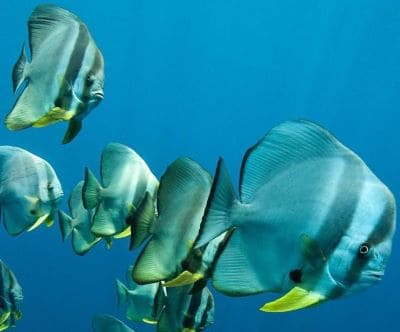Home › Top Destinations › Asia › Thailand › Koh Tao › Sail Rock
Scuba Diving at Sail Rock Koh Tao
Head south from Koh Tao to Koh Phangan and a monumental granite mountain rises dramatically from the sea bed to create the dive site called Sail Rock.
This help guide contains information about Sail Rock dive site, including the maximum depth levels, recommended diver training, and the local marine life.
What Months are Best for Diving in Koh Tao
In fact, the Chumphon Archipelago contains dozens of sun-kissed bays on the islands. But, the premier spots for divers and snorkelers are:
- Koh Phangan
- Koh Samui
- Mu Ko Chumphon National Park
- Turtle Island (Koh Tao)
Koh Tao is a compact kidney-shaped island that has about twenty one (21) square kilometres of total land mass.
Nevertheless, the pristine white sand beaches and azure blue water have transformed Koh Tao Island into one of the top places for scuba diving holidays in southern Thailand.
Here's the thing:
Most scuba divers want to explore destinations that are sunny and have calm conditions underwater. Well, Koh Tao has over three hundred days of year-round sunshine and the temperature of the water is a constant 29° Celsius (84° Fahrenheit).
As a consequence of that, it's fair to say diving in Koh Tao is an annual activity. But, divers need to be mindful that the southwest monsoons usually arrive towards the end of October and may continue until the end of January.
At certain times of the year, the south western gulf can have thirty (30) metres of underwater visibility. Hence, the best months for divers to enjoy clear water dives are July, August, and September.
Pro Tip: Check out our sea life section for interesting facts about whale sharks that tend to make an appearance around the islands near Koh Tao during the months of April and May.
Tips for Diving at Sail Rock (Hin Bai)
The craggy pinnacle dive is famous and popular with Sail Rock divers for its vertical, hollow chimney. You can enter the chimney around five (5) metres below the surface and exit around eighteen (18) metres further down.
Following that, experienced divers will go down to the ocean floor at thirty (30) metres and slowly circumnavigate the contours of the granite pinnacle. You can also make a spiral ascent as you head back to the surface.
Inexperienced divers may find it too challenging to swim against the prevailing currents. Hence, it's best to stay on the leeward side of the rock to get maximum shelter.
But wait -there's more:
Strong sunlight filters down and collides with this huge granite boulder. As it does so, fishes shimmer in the crystal blue haze. You should also see trevallies darting into the dive zone to feed, constantly harassing schools of nervous fish fry.
The seemingly ever-present (and "diver-friendly") orbiculate batfish cue up for photo opportunities, and swarms of glassfish cloud the view.
You should also see hinge-beak shrimp and boxer shrimp hiding in the coral wall. They will venture out of the safe zones to clean inside the mouths of patiently-waiting moray eels.
Pro Tip: Sheltered bays with areas of open sand and little water movement are ideal locations for local dive shops to conduct the Discover Scuba Diving program. But, Sail Rock diving spot is deeper and less protected from strong currents. Thus, the recommended scuba training for this location includes PADI Advanced Open Water Diver, PADI Deep Diver, and PADI Fish Identification.
Marine Life at Sail Rock Dive Site
Koh Tao dive sites are good places to see big fishes (e.g. pelagics). Plus, divers should expect to catch sightings of common marine life native to the lower Gulf of Thailand, especially during the plankton blooms in March and April, such as:
- Banded Coral Shrimp (Stenopus hispidus)
 Batfish (Platax teira)
Batfish (Platax teira)- Bearded scorpionfish (Scorpaenopsis barbata)
- Blue spotted stingray
- Bigeye Trevally (Caranx sexfasciatus)
- Chevron barracuda
- Christmas tree worm (Spirobranchus giganteus)
- False moorish idol (schooling bannerfish)
- Giant Black Coral Whip (Cirrhipathes)
- Giant Clams (Tridacna gigas)
- Marine Mollusks (e.g. oysters)
- Moray eel
- Pink Skunk Clownfish (Amphiprion perideraion)
- Malabar grouper (Epinephelus malabaricus)
- Orange Cup Coral (Tubastraea coccinea)
- Sea Anemones (phylum Cnidaria)
- Sea Sponges (phylum Porifera)
- Spanish Mackerels (Scomberomorini)
- Talang Queenfish (Scomberoides commersonnianus)
- Yellowtail Barracuda (Sphyraena flavicauda)
- Yellowtail Fusilier (Caesio cuning)
Pro Tip: The sites offer good opportunities to explore sea life that lives around hard and soft corals. For example, hard varieties include brain, table, staghorn corals, and lobe coral (Porites lobata). Soft coral species at Sail Rock include mushroom coral and toadstool leather corals (Genus Sarcophyton).
Related Information and Help Guides
- Aow Leuk Dive Site Koh Tao for Diving and Snorkeling
- Hin Wong Bay Dive Site Koh Tao East Coast in Thailand
- Information about Shark Point Dive Site near Phuket
- Is Chumphon Pinnacle the Best Place to Dive in Koh Tao?
- Laem Thian Dive Sites in Koh Tao for Beginners
- HTMS Sattakut Wreck Dive Site Koh Tao Thailand
- Shark Island Dive Site in the Lower Gulf of Thailand
- The Best Scuba Diving and Snorkeling Sites in Koh Samui
Pro Tip: This short clip [55 seconds] presented by "Black Turtle Dive" contains footage of sea creatures in their natural habitat at Sail Rock dive site in Koh Tao, Thailand.